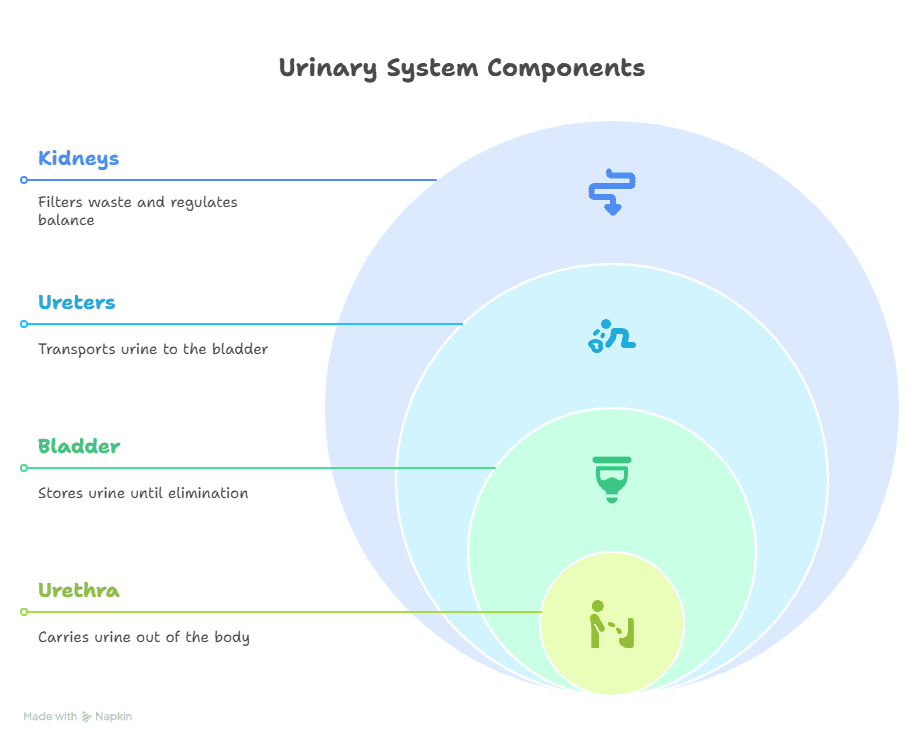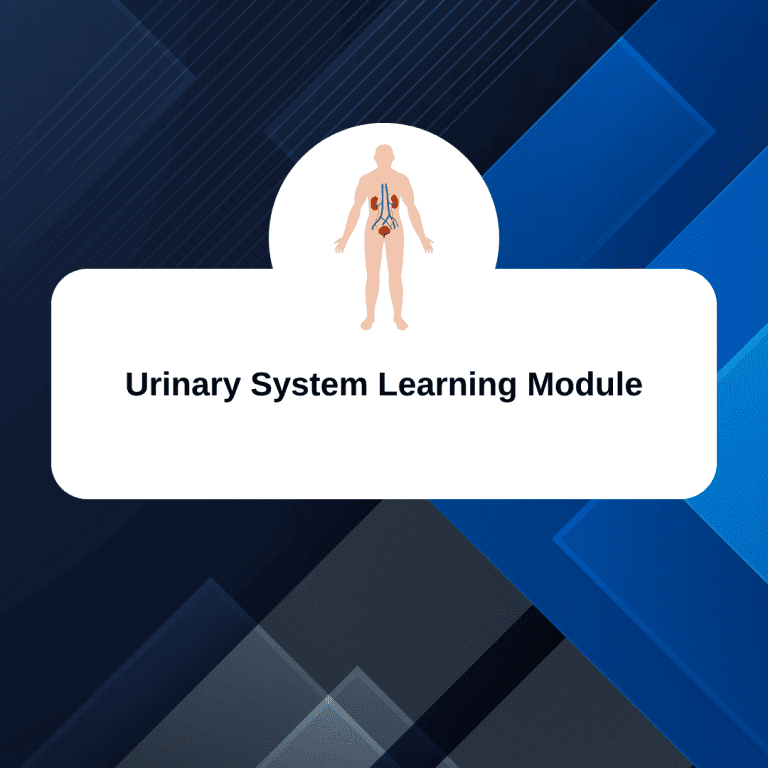Welcome to the learning module on the Urinary System! In this module, we will explore the important role that the urinary system plays in our bodies. The urinary system is composed of organs that work together to help the body eliminate waste and maintain a healthy balance of fluids. By learning about the urinary system, you will gain a deeper understanding of how your body functions and how to maintain its health.
Objectives:
- Learn about the organs that make up the urinary system
- Understand the functions of each organ in the urinary system
- Explore how the urinary system helps maintain the body’s balance of fluids
- Identify common problems that can affect the urinary system
- Learn how to keep the urinary system healthy through proper hydration and diet
Section 1: What is the Urinary System
The urinary system is an integral part of the body that helps us eliminate waste and excess fluids. It includes organs like the kidneys, bladder, and urethra. The kidneys filter the blood, removing waste and excess water to make urine.
The urine travels through tubes called ureters to the bladder, where it is stored until we are ready to urinate. When we urinate, the urine leaves the body through the urethra. Understanding how the urinary system works is essential for pre-med students to comprehend how the body functions and maintain its health.
Structure and components of the urinary system.

| Urinary System Parts | Definition | Function |
|---|---|---|
| Kidneys | Organs that filter waste products from the blood to form urine. | Help regulate water balance and remove toxins from the body. |
| Ureters | Tubes that carry urine from the kidneys to the bladder. | Transport urine to the bladder for storage before elimination. |
| Bladder | An organ that stores urine until it is ready to be expelled from the body. | Stores and releases urine when necessary. |
| Urethra | A tube that carries urine from the bladder to outside the body. | A tube that carries urine from the bladder to the outside of the body. |
The importance of the urinary system in maintaining homeostasis.
The urinary system is crucial in maintaining the balance and health of our bodies. It helps remove waste and excess water from our blood, thereby keeping the proper levels of chemicals in our bodies.
This helps maintain a stable internal environment, also known as homeostasis. Without the urinary system, harmful substances could build up in our bodies and make us sick. So, it’s essential to take care of our kidneys and bladder to keep our bodies working properly.
Games and Activities
Section 2: Anatomy of the Kidneys

Location and External Structure of the Kidneys.
| Part of External Structure | Definition | Location | Function |
|---|---|---|---|
| Cortex | The inner part of the kidney that helps concentrate urine. | Located on the outer edge of the kidney. | Filters blood and removes waste products to form urine. |
| Medulla | The inner part of the kidney that helps with the concentration of urine. | Located beneath the cortex. | Concentrates urine by reabsorbing water and salts. |
| Renal Pelvis | A funnel-shaped structure that collects urine from the nephrons. | Located at the center of the kidney. | Transports urine from the kidney to the bladder for excretion. |
Internal structure of the kidneys and their functions.
| Internal Structure of Kidneys | Definition | Location | Function |
|---|---|---|---|
| Cortex | The outer layer of the kidney | Located on the outer edges of the kidney | Filters blood and removes waste products |
| Medulla | The inner part of the kidney | Located beneath the cortex | Situated in the center of the kidney |
| Pelvis | A funnel-shaped structure | Located at the center of the kidney | Helps in the concentration of urine and the reabsorption of water |
Renal blood supply and filtration process in the kidneys.
The kidneys get their blood supply from the renal arteries. When blood enters the kidneys, it goes through tiny blood vessels called capillaries.
These capillaries have small holes that allow waste products and extra water to be filtered out of the blood. This process is called filtration.
The clean blood then leaves the kidneys through the renal veins. The waste products and extra water are filtered out from urine, which is then sent to the bladder for storage until it is ready to be released from the body.
Kidney Structures and Their Functions
| Kidney Structure | Function |
|---|---|
| Nephrons | Filter waste and extra water from the blood to make urine |
| Renal Cortex | The inner part of the kidney that helps concentrate urine |
| Renal Medulla | Inner part of the kidney that helps concentrate urine |
| Renal Pelvis | Collects urine from the nephrons and sends it to the bladder |
Games and Activities
- Anatomy of the Kidneys Flashcards
- Anatomy of the Kidneys Quiz
- Anatomy of the Kidneys Vocabulary Hangman
Section 3: Urinary System Disorders
The urinary system helps the body eliminate waste through urine. The urinary system can sometimes experience problems.
Common disorders affecting the urinary system.
Several common disorders can affect the urinary system. One of these is a urinary tract infection, which occurs when bacteria enter the urinary tract and cause pain when urinating.
Another common disorder is kidney stones, which are hard deposits that form in the kidneys and can cause intense pain when passing them.
Kidney disease is another disorder that affects the kidneys’ ability to filter waste from the blood, resulting in symptoms such as swelling and fatigue. It’s essential to seek medical help if you experience symptoms of any urinary system disorder.
| Disorder | Definition |
|---|---|
| Urinary Tract Infection (UTI) | Kidney stones are hard deposits that form in the kidneys and can cause severe pain in the back or side. They can also block the flow of urine, resulting in increased pain and discomfort. |
| Kidney Stones | Kidney stones are hard deposits that form in the kidneys and can cause severe pain in the back or side. They can also block the flow of urine, causing more pain and discomfort. |
| Urinary Incontinence | Urinary incontinence is when a person has trouble controlling their bladder, leading to leaks or accidents. It can happen due to weak bladder muscles or nerve problems. |
| Bladder Cancer | Bladder cancer is a type of cancer that starts in the bladder. Symptoms can include blood in the urine, pain during urination, and frequent urination. |
Symptoms and Treatments for Urinary System Disorders.
When someone has a urinary system disorder, they may experience symptoms like frequent urination, pain while urinating, and blood in their urine. Infections, kidney stones, or other issues with the bladder or kidneys can cause these problems.
Treatment for urinary system disorders often involves medications to combat infections, pain relief, and adjustments to diet or lifestyle. In severe cases, surgery may be necessary to correct the issue. It’s essential to consult a doctor if you experience symptoms of a urinary system disorder, as they can help alleviate your condition.
| Symptoms | Treatments |
|---|---|
| Frequent urination | Drink plenty of water and avoid caffeine and alcohol |
| Blood in urine | Treatment may include antibiotics, medications to reduce inflammation, or procedures to remove kidney stones or other blockages |
| Pain or burning sensation while urinating | Antibiotics prescribed by a doctor |
| Urinary tract infections | Antibiotics, drinking cranberry juice, and practicing good hygiene |
| Kidney stones | Medication to help pass the stones or surgical removal |
The Impact of Urinary System Disorders on Overall Health.
The urinary system plays a crucial role in maintaining the body’s health. When there are disorders in the urinary system, it can impact a person’s overall health. For example, if someone has a urinary tract infection, it can cause pain and discomfort.
If not treated properly, it can lead to more serious problems like kidney damage. This is why it is essential to take care of the urinary system and seek medical attention if any issues arise. Maintaining a healthy urinary system can help support overall well-being.
Games and Activities
- Urinary System Disorders Flashcards
- Urinary System Disorders Vocabulary Hangman
- Urinary System Disorders Quiz
Conclusion
You’ve completed the learning module on the Urinary System! Congratulations on finishing this critical topic. Throughout this module, you have learned:
- What the urinary system is and its primary functions
- The organs that make up the urinary system
- How urine is produced and excreted
- Common urinary system disorders and how they can be treated
By understanding these objectives, you now have a clearer understanding of how your body functions and how to maintain a healthy urinary system. Keep learning and exploring the fantastic world of anatomy!
What to Study Next?
It is recommended that you study the Sensory system next. This system is responsible for helping you perceive things through your senses of sight, hearing, taste, smell, and touch. By understanding how your senses function, you can gain a deeper understanding of how your body interacts with the world around you.
This will help you better understand how your body functions as a whole. Take your time to study each sense and how they work together to help you experience the world in different ways. Have fun learning about the exceptional abilities of your sensory system!
